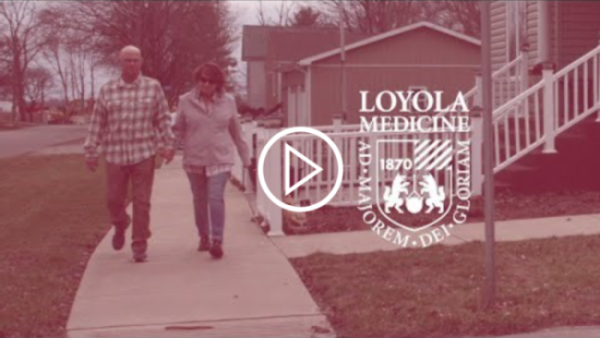Double Lung Transplant Saves Man with Asbestosis
June 30, 2025
After spending years working with asbestos and suffering the consequences, 66-year-old Michael Mihalik of Kiwana, Indiana, believed he wasn’t a candidate for a lung transplant. He feared his life was over, until what he calls “divine intervention” led him to doctors at Loyola Medicine and a life-saving transplant.
Mihalik was exposed to asbestos for most of his life. “Growing up in the ‘60s and ‘70s, everything was asbestos”, said Mihalik. “If you were middle class, and you did all your own work because you couldn't afford to hire people to do stuff for you, you were exposed to this stuff.” He was exposed heavily between 1978-1982 during various jobs in steel plants and lumber yards.
Asbestosis is considered an occupational lung disease caused by inhaling asbestos fibers. People who work with this material are exposed to the fibers. After inhalation, the small fibers are deposited in the lungs, which can lead to scarring called pulmonary fibrosis. Patients may develop shortness of breath, cough and low oxygen levels. It’s a permanent condition that can progress in some patients and a lung transplant becomes their only option.
It wasn't until 1985, after nearly a decade of inhaling the material, that Mihalik first heard about the dangers of asbestos. It was previously believed that, for a patient with asbestos exposure, surgery would lead to the spreading of the particles to other organs, causing mesothelioma, a myth that stuck with Mihalik for years.
“Loyola is the oldest lung transplant program in the state,” said Loyola transplant pulmonologist Sana Quddus, MD. “We have historically done transplants for patients who have been deemed high risk at other centers. Our surgeons, our transplant team, and our ICU physicians are fully equipped to take care of these high-risk cases.”
By December 2023, his condition had worsened, requiring 10 liters of oxygen at all times. Convinced he would not live much longer, Mihalik visited New York to say goodbye to his children. While visiting a family member, he noticed an article in a newspaper on their coffee table. The article shared the story of a double lung transplant in an asbestosis patient. “I started to have some hope,” said Mihalik. “I bought ten copies of that newspaper and brought them back to my pulmonologist.” The pulmonologist suggested sending Mihalik’s information to Loyola.
“She said ‘don’t get your hopes up, we may not hear from them for a couple of months’”, said Mihalik. “Three days later, Loyola called me to interview me and start the process for testing.”
A short time later, Mihalik traveled to Loyola to meet with a team of physicians. After reviewing his case and medical records, doctors told Mihalik that due to his overall good health, he was eligible for a transplant, and he was being placed on the list.
“At Loyola, we give hope to the hopeless," said Liz Schramm, RN, post-lung transplant coordinator. “In Mike’s case, he was hopeless, and we were able to give him a chance at life that he might not have otherwise had.”
One year after saying goodbye to his children, Mihalik was in the hospital again, fearing the worst, when doctors told him that a match had been found. He received his double lung transplant on December 7, 2024.
“It's just an unbelievable experience,” said Mihalik. "I have a life again. It's been three months. I can walk up and down stairs again. I can go outside and walk. I walk almost three miles a day again. I don't get winded. My oxygen levels stay at 98%. It's just an overwhelming feeling; it’s a gift of life.”
Watch more about Mihalik’s story here: Double Lung Transplant Restores Life to Asbestosis Patient
